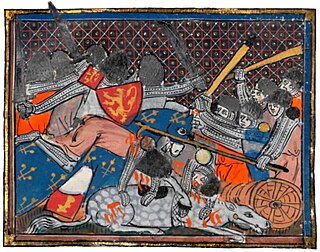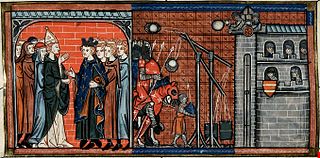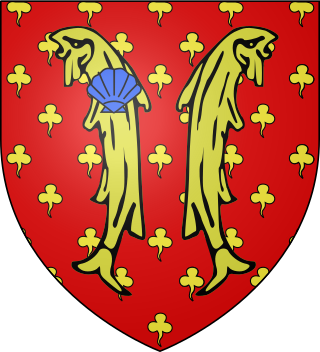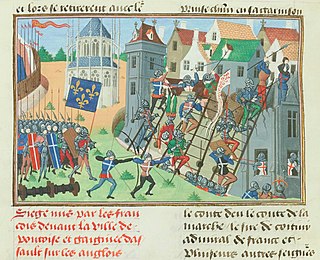
The Battle of Ivry was fought on 14 March 1590, during the French Wars of Religion. The battle was a decisive victory for Henry IV of France, leading French royal and English forces against the Catholic League by the Duc de Mayenne and Spanish forces under the Count of Egmont. Henry's forces were victorious and he went on to lay siege to Paris.

The Battle of the Golden Spurs or 1302 Battle of Courtrai was a military confrontation between the royal army of France and rebellious forces of the County of Flanders on 11 July 1302 during the 1297–1305 Franco-Flemish War. It took place near the town of Kortrijk in modern-day Belgium and resulted in an unexpected victory for the Flemish.

Armand de Gontaut, Baron of Biron was a soldier, diplomat and Marshal of France. Beginning his service during the Italian Wars, Biron served in Italy under Marshal Brissac and Guise in 1557 before rising to command his own cavalry regiment. Returning to France with the Peace of Cateau-Cambrésis he took up his duties in Guyenne, where he observed the deteriorating religious situation that was soon to devolve into the French Wars of Religion. He fought at the Battle of Dreux in the first civil war. In the peace that followed he attempted to enforce the terms on the rebellious governorship of Provence.

The siege of Calais occurred at the conclusion of the Crécy campaign, when an English army under the command of King Edward III of England successfully besieged the French town of Calais during the Edwardian phase of the Hundred Years' War.

James I of Bourbon, was a French prince du sang, and the son of Louis I, Duke of Bourbon and Mary of Avesnes. He was Count of Ponthieu from 1351 to 1360, and Count of La Marche from 1341 to his death.
The Battle of Saintes was fought on 1 April 1351 during the Hundred Years' War between French and English forces. The French were besieging the town of Saint-Jean-d'Angély when an English relief force arrived. The English force was victorious, but was unable to fulfill its mission, to resupply the besieged. The town fell to the French on 31 August.
The Battle of Mauron was fought in 1352 in Brittany during the Breton War of Succession between an Anglo-Breton force supporting the claim of Jean de Montfort and a Franco-Breton force supporting the claim of Charles de Blois. The Anglo-Bretons were victorious. The battle took place in the context of the Hundred Years War.

The Battle of Taillebourg, a major medieval battle fought in July 1242, was the decisive engagement of the Saintonge War. It pitted a French Capetian army under the command of King Louis IX, also known as Saint Louis, and his younger brother Alphonse of Poitiers, against forces led by King Henry III of England, his brother Richard of Cornwall and their stepfather Hugh X of Lusignan.

The Loire Campaign was a campaign launched by Joan of Arc during the Hundred Years' War. The Loire was cleared of all English and Burgundian troops.

The siege of La Rochelle of 1224 was the decisive engagement in the campaign between the Capetians and the Plantagenets for control of Poitou. French royal forces commanded by Capetian king Louis VIII laid siege to the strategic port of La Rochelle and its garrison of Poitevin and English soldiers commanded by Savari de Mauléon. The port had long been a staging ground for Plantagenet efforts to regain their continental lands lost to the French crown since 1203. The siege lasted from July to August 1224, and resulted in La Rochelle's citizens surrendering the city to Louis after the failure of English relief to emerge. The siege of La Rochelle was the crowning event of the Capetian conquest of Poitou from the Plantagenets. With Poitou in Capetian hands, only Gascony remained under Plantagenet rule on the continent.

Guy II de Nesle, Lord of Mello, was a Marshal of France (1348) who was killed in the Battle of Mauron.

The Battle of Calais took place in 1350 when an English force defeated an unsuspecting French army which was attempting to take the city. Despite a truce being in effect the French commander Geoffrey de Charny had planned to take the city by subterfuge, and bribed Amerigo of Pavia, an Italian officer of the city garrison, to open a gate for them. The English king, Edward III, became aware of the plot and personally led his household knights and the Calais garrison in a surprise counter-attack. The French were routed by this smaller force, with significant losses and all their leaders captured or killed.
The siege of Saint-Denis was the last instance of cooperation between the English and their Burgundian allies in the Hundred Years' War. Saint-Denis, the traditional burial place of the kings of France, was located in the outskirts of English-held Paris, and had been captured by the French a couple of months earlier. The enemy presence there critically endangered the English position in the capital, and, aiming to retake it urgently, the English moved onto the town in August with a handful of Burgundian auxiliaries. The siege was undertaken during the peace congress of Arras, during which no end to the fighting was seen, as both sides struggled to gain ground around and over Paris. The English were victorious at St. Denis after the French garrison surrendered due to lack of external support.
The Gascon campaign of 1294 to 1303 was a military conflict between English and French forces over the Duchy of Aquitaine, including the Duchy of Gascony. The Duchy of Aquitaine was held in fief by King Edward I of England as a vassal of King Philip IV of France. Starting with a fishing fleet dispute and then naval warfare, the conflict escalated to open warfare between the two countries. In spite of a French military victory on the ground, the war ended when the Treaty of Paris was signed in 1303, which restored the status quo. The war was a premise to future tensions between the two nations culminating in the Hundred Years' War.

Lancaster's chevauchée of 1346 was a series of offensives directed by Henry, Earl of Lancaster, in southwestern France during autumn 1346, as a part of the Hundred Years' War.

Sir Walter Bentley was an English knight who fought during the Hundred Years' War.
Raymond-Guilhem de Caupenne, Seigneur of Caupenne, was a French noble who took part in the Hundred Years War. He led the defense of Saint-Jean-d'Angély in 1351 against a French force laying siege to the town. He died in 1374.

The siege of Pontoise took place during the Hundred Years War. French forces led by King Charles VII of France besieged and captured the last English stronghold in Île de France, eliminating the English threat to Paris.

The siege of Montargis took place during the Hundred Years War. A French relief army under Jean de Dunois routed an English force led by the Earl of Warwick.
The siege of Guînes took place from May to July 1352, when a French army under Geoffrey de Charny unsuccessfully attempted to recapture the French castle at Guînes which had been seized by the English the previous January. The siege was part of the Hundred Years' War and took place during the uneasy and oft-broken truce of Calais.















